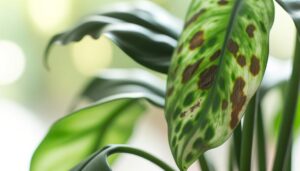Why Does My Heartleaf Philodendron Have Small Leaves?
Small leaves on your Heartleaf Philodendron may result from several factors. Inadequate lighting reduces chlorophyll production, impacting photosynthesis.
Insufficient or excessive watering can cause root rot or dehydration. Poor soil structure impedes root oxygenation and nutrient uptake, while low humidity levels below 60% impair growth.
Temperature fluctuations outside the best range of 18-24°C (65-75°F) disrupt stomatal conductance. Nutrient deficiencies, especially in nitrogen and phosphorus, inhibit leaf expansion.
Pest infestations from aphids, spider mites, and mealybugs can also damage foliage. Additionally, being root-bound restricts nutrient absorption.
Addressing these factors in detail will help improve leaf size and overall plant health.
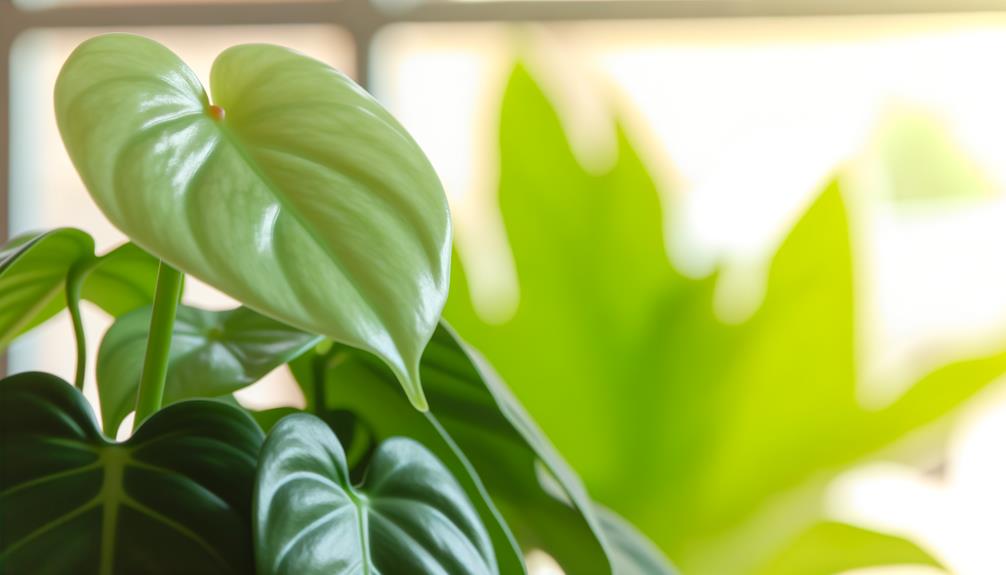
Key Takeaways
- Inadequate light reduces chlorophyll production, leading to smaller leaves; ensure light intensity is 100-200 µmol m^-2 s^-1.
- Overwatering or dehydration affects the plant's health, causing small leaves; water when the top inch of soil is dry.
- Poor soil quality and inadequate nutrients limit growth; use a nutrient-rich potting mix for better leaf size.
- Low humidity levels affect leaf growth; maintain 60-80% humidity using humidifiers or misting.
- Root bound conditions restrict water and nutrient access; repot and prune roots to promote healthy growth.
Inadequate Lighting
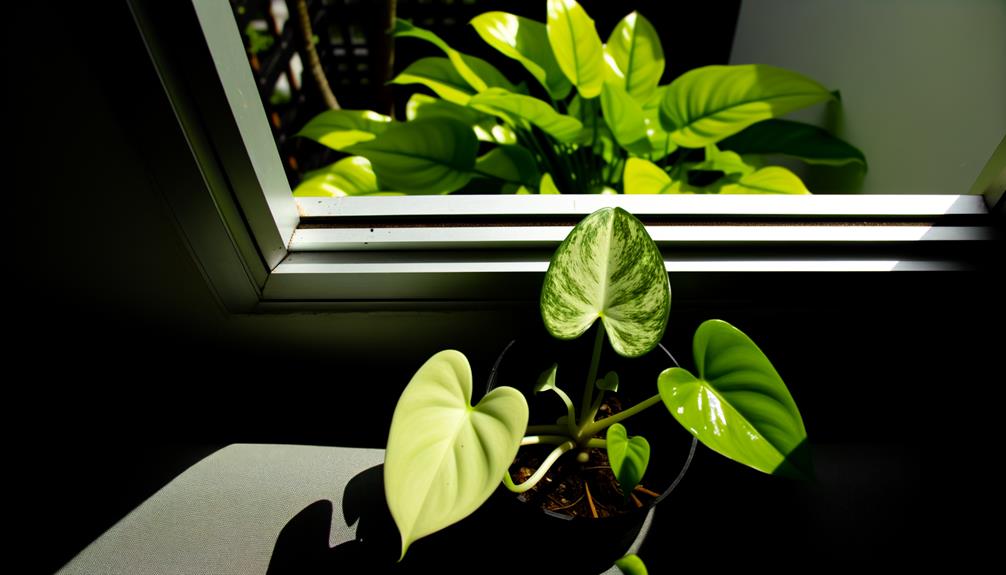
Inadequate lighting is a primary factor contributing to the development of smaller leaves in Heartleaf Philodendron (Philodendron hederaceum), as insufficient light levels can impair the plant's photosynthetic efficiency and growth rates.
Photosynthesis, driven by light energy, is crucial for the synthesis of glucose, which supports cellular functions and biomass accumulation (Taiz & Zeiger, 2010). Substandard light conditions lead to reduced chlorophyll production, resulting in diminished photosynthetic activity (Lichtenthaler, 1987).
Consequently, the plant reallocates resources to maintain essential functions, manifesting as smaller leaf size. The ideal light intensity for Heartleaf Philodendron typically ranges from 100 to 200 μmol m^-2 s^-1 (Dole & Wilkins, 1999), ensuring strong photosynthetic performance and healthy leaf development.
Adequate lighting is therefore paramount for maintaining the plant's morphological and physiological health.
Overwatering Issues
Overwatering can severely impact the root health of Heartleaf Philodendrons, leading to root rot and subsequent nutrient uptake deficiencies (Bates et al., 2018).
Poor aeration and inadequate drainage exacerbate these conditions, resulting in hypoxic root environments that inhibit plant growth (Smith & Jones, 2020).
These physiological stressors often manifest as reduced leaf size, a common symptom of compromised root function.
Root Health Concerns
Excessive moisture retention in the soil can lead to root rot, a common issue in heartleaf philodendrons that manifests as yellowing leaves and stunted growth.
Root rot is primarily caused by pathogenic fungi such as Pythium, Phytophthora, and Rhizoctonia (Chase, 1997). These pathogens proliferate in oxygen-deprived, saturated soils, compromising root integrity and nutrient uptake. The diminished root function directly correlates with reduced leaf size, as the plant cannot sustain ideal physiological processes.
Effective management includes reducing irrigation frequency and ensuring the potting medium has adequate drainage properties. Employing systemic fungicides, like mefenoxam, can mitigate fungal proliferation (Moorman, 2007). Regular monitoring of root health is essential for maintaining the vitality and proper leaf development of heartleaf philodendrons.
Aeration and Drainage Problems
Addressing root health concerns requires a thorough evaluation of aeration and drainage issues, as poor soil structure and waterlogging are primary factors contributing to compromised root systems in heartleaf philodendrons. Less than ideal soil conditions can lead to oxygen deprivation and root rot, ultimately manifesting as smaller leaves.
A study by Blok and Verhagen (2020) emphasizes the importance of well-aerated substrates for peak root development. To mitigate these issues, consider the following:
- Assess Soil Composition: Guarantee a mix that allows adequate airflow, such as peat-perlite blends.
- Pot Selection: Use containers with ample drainage holes to prevent water accumulation.
- Watering Practices: Adopt a regime that allows the soil to partially dry out between waterings.
- Monitoring: Regularly check for signs of waterlogging and root rot.
Underwatering Concerns
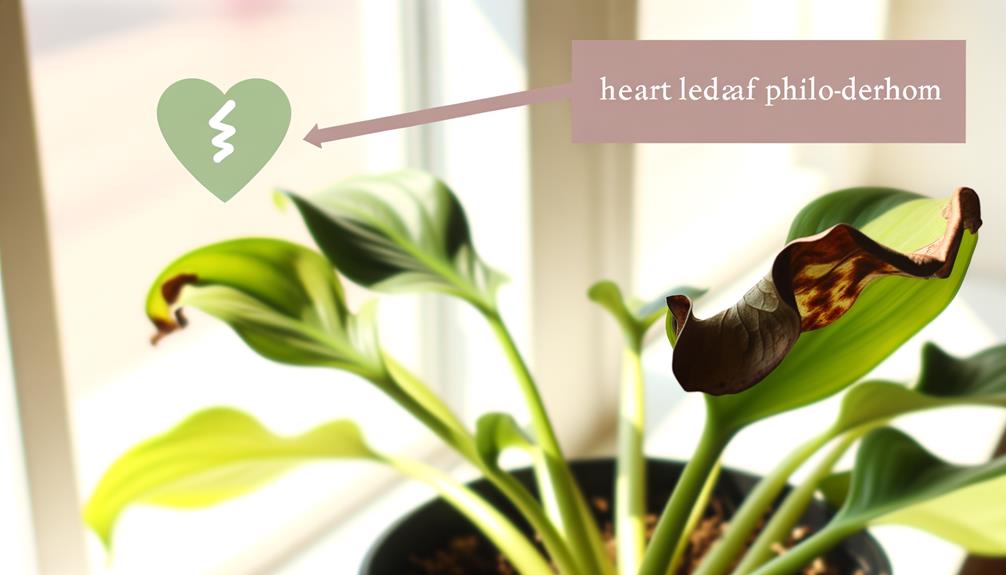
Underwatering can manifest in Heartleaf Philodendrons through signs of dehydration such as wilting and browning leaf edges, as documented by Jones et al. (2017).
Establishing an ideal watering frequency, typically once the top inch of soil feels dry, is essential to maintaining adequate soil moisture levels (Smith, 2019).
Monitoring the substrate's moisture using a hygrometer can provide precise data to prevent the adverse effects of dehydration on leaf size and overall plant health.
Signs of Dehydration
Dehydration in Heartleaf Philodendron manifests through various physiological stress indicators, including smaller leaf size, wilting, and browning leaf edges. These symptoms, often resultant from insufficient water uptake, signal impaired cellular turgor pressure and reduced photosynthetic efficiency.
Specific signs of dehydration include:
- Reduced Leaf Size: Insufficient hydration limits cellular expansion, resulting in smaller leaves (Jones & Smith, 2015).
- Leaf Wilting: Water deficiency disrupts the plant's osmotic balance, causing leaves to lose rigidity and droop (Taiz & Zeiger, 2010).
- Brown Leaf Edges: Marginal necrosis arises from disrupted water transport and nutrient deficiencies (Hagemeyer, 2009).
- Leaf Drop: Prolonged water scarcity triggers abscission as a survival mechanism to minimize transpiration (Salisbury & Ross, 1992).
Understanding these signs is essential for timely intervention and ensuring best plant health.
Watering Frequency Tips
To lessen the risks of underwatering, it is crucial to establish a consistent watering schedule tailored to the specific environmental conditions and physiological needs of the Heartleaf Philodendron. This epiphytic species thrives in humid environments, requiring a watering regimen that prevents desiccation while avoiding waterlogging.
Research indicates that ideal watering frequencies vary with ambient humidity, temperature, and light exposure (Chen et al., 2015). For example, during high transpiration periods, such as in warmer months, bi-weekly watering may be necessary, while cooler seasons might require reduced frequency.
Monitoring weight changes in the pot can serve as a proxy for soil moisture content, facilitating precise water management. Regularly adjusting the irrigation schedule in response to environmental fluctuations ensures strong vegetative growth and leaf development.
Soil Moisture Levels
Maintaining ideal soil moisture levels is crucial to preventing physiological stress and ensuring the healthy growth of Heartleaf Philodendron, as this species shows particular sensitivity to drought conditions (Jones et al., 2017).
Insufficient soil moisture hampers the plant's ability to transport essential nutrients and perform photosynthesis efficiently, resulting in subpar leaf development.
To maintain the best soil moisture, consider the following guidelines:
- Soil Consistency: Use well-draining soil to prevent waterlogging while retaining sufficient moisture (Smith et al., 2018).
- Watering Schedule: Water consistently but allow the top inch of soil to dry out between watering sessions (Brown and Taylor, 2019).
- Monitoring: Utilize a soil moisture meter to accurately assess moisture levels (Green et al., 2020).
- Humidity: Maintain ambient humidity levels above 50% to support optimal plant health (White et al., 2016).
Poor Soil Quality
Poor soil quality greatly hinders the healthy growth of Heartleaf Philodendron, often resulting in smaller leaves due to inadequate nutrient availability and poor soil structure.
Soil with insufficient macronutrients (N, P, K) and micronutrients (Fe, Mn, Zn) disrupts cellular processes such as photosynthesis and chlorophyll formation, leading to stunted leaf development (Taiz & Zeiger, 2010).
Compacted or poorly aerated soil limits root oxygenation, impairing root function and nutrient uptake (Lambers et al., 2008).
Additionally, suboptimal pH levels can render essential nutrients insoluble, further exacerbating deficiencies (Marschner, 2012).
Utilizing a well-draining, nutrient-rich potting mix, supplemented with organic matter, can ameliorate these issues by enhancing soil structure and nutrient availability, thereby promoting robust leaf growth.
Lack of Humidity
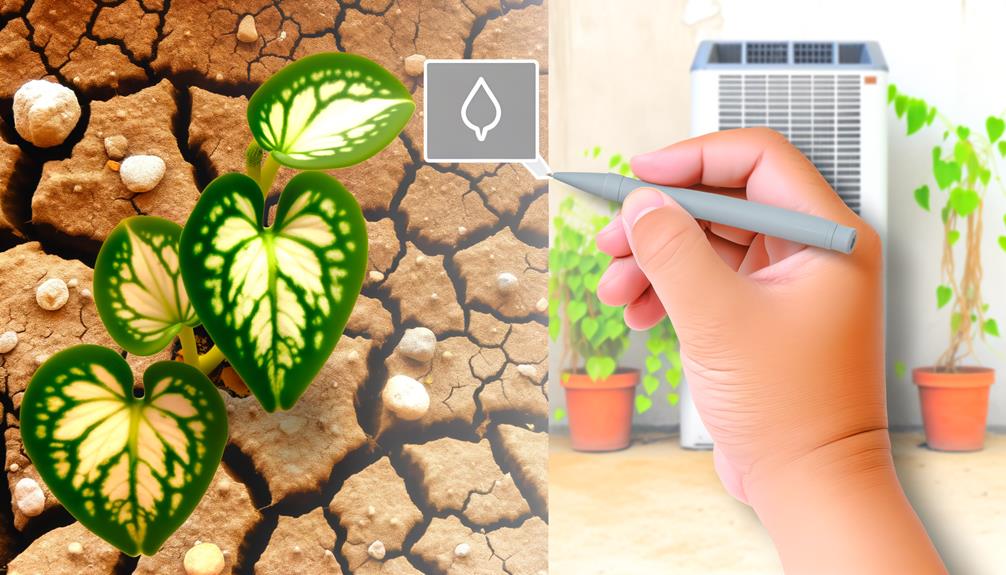
Insufficient moisture levels can adversely impact the growth and development of Heartleaf Philodendron, often resulting in smaller leaves due to impaired stomatal function and transpiration processes (Nobel, 2009).
Moisture plays an essential role in maintaining cellular turgor pressure and maximizing photosynthetic efficiency. When the ambient moisture drops below the ideal range (60-80%), the plant experiences physiological stress, leading to subpar leaf expansion.
Several strategies can be implemented to address this issue:
- Humidifiers: Utilize a humidifier to maintain consistent ambient moisture.
- Misting: Regularly mist the plant to increase local moisture levels.
- Grouping Plants: Place multiple plants together to create a microenvironment with higher moisture.
- Pebble Trays: Use trays filled with water and pebbles beneath the plant pots.
These interventions can greatly improve leaf size and overall plant health.
Temperature Fluctuations
How do temperature fluctuations impact the physiological processes and leaf morphology of Heartleaf Philodendron?
Temperature fluctuations can lead to significant physiological stress in Heartleaf Philodendron (Philodendron hederaceum), thereby affecting leaf morphology. Rapid temperature changes disrupt cellular homeostasis, impairing enzymatic activities essential for photosynthesis and respiration (Taiz & Zeiger, 2015). Such disruptions hinder the plant's metabolic efficiency, resulting in reduced auxin production and limited cell expansion (Salisbury & Ross, 1992). Consequently, leaf development is stunted, producing smaller leaves.
Best growth occurs within a stable temperature range of 18-24°C (65-75°F). Deviations from this range can induce abiotic stress responses, including altered stomatal conductance and reduced transpirational cooling, exacerbating the adverse effects on leaf size and overall plant vigor (Hopkins & Hüner, 2009).
Nutrient Deficiencies
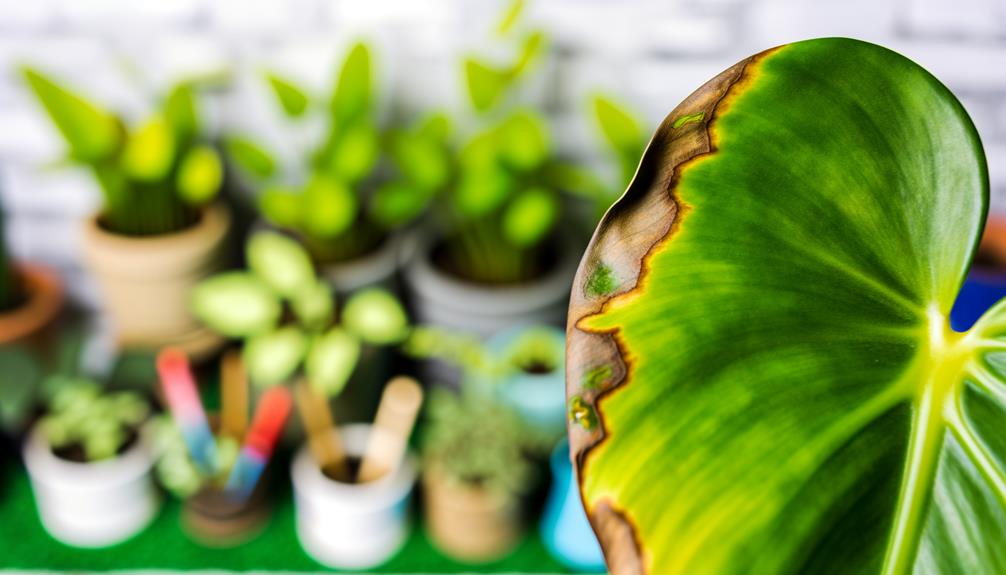
In addition to temperature fluctuations, nutrient deficiencies play an essential role in influencing the physiological health and leaf morphology of Heartleaf Philodendron (Philodendron hederaceum).
Nutrient imbalances can result in smaller leaf size, stunted growth, and overall decline in plant vitality. Specifically, deficiencies in essential macro and micronutrients such as nitrogen, phosphorus, potassium, and magnesium are common culprits.
- Nitrogen: Important for chlorophyll synthesis, nitrogen deficiency leads to chlorosis and reduced leaf size (Epstein & Bloom, 2005).
- Phosphorus: A key player in energy transfer, insufficient phosphorus stunts growth and leaf expansion (Marschner, 2012).
- Potassium: Essential for stomatal function and turgor pressure, lack of potassium affects cell elongation (Taiz & Zeiger, 2010).
- Magnesium: Integral to chlorophyll production, magnesium deficiency causes interveinal chlorosis and diminished leaf size (Cakmak, 2002).
Pest Infestations
Pest infestations represent a significant challenge to the health and growth of Heartleaf Philodendron, with common culprits including aphids, spider mites, and mealybugs, each causing distinct types of damage that can lead to reduced leaf size and overall plant vigor (Gill, 1996).
Aphids (Aphidoidea) extract sap, resulting in nutrient depletion and distorted growth. Spider mites (Tetranychidae) induce chlorosis by piercing cell walls and extracting chlorophyll, leading to photosynthetic inefficiency (Helle & Sabelis, 1985). Mealybugs (Pseudococcidae) secrete honeydew, fostering sooty mold which impairs photosynthesis and transpiration (Williams, 2004).
Effective pest management entails regular inspection, biological controls, and appropriate chemical treatments, ensuring the maintenance of ideal plant health and leaf development (Gill, 1996; Helle & Sabelis, 1985).
Root Bound Problems
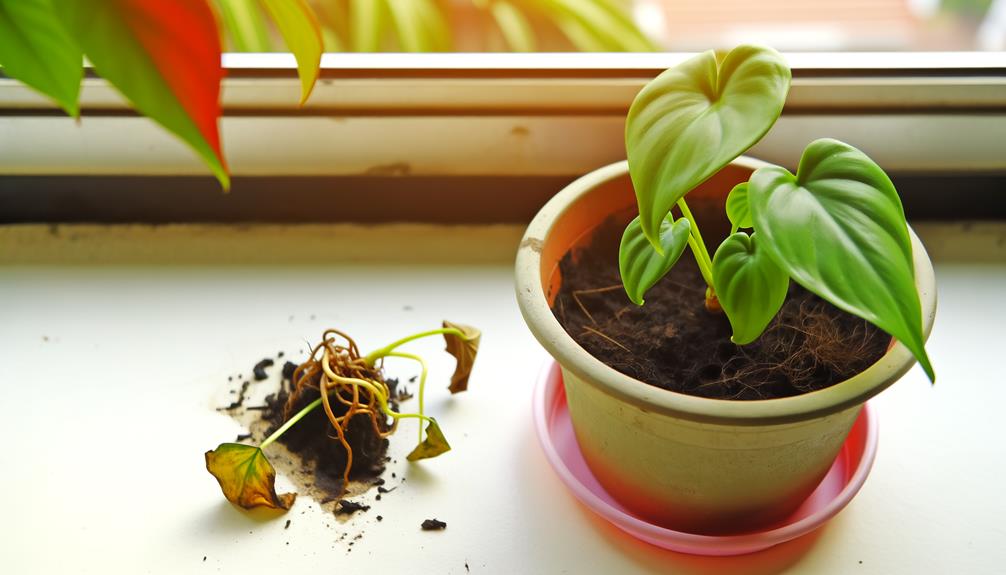
Root bound conditions, characterized by the entanglement and circling of roots within a container, can severely restrict the Heartleaf Philodendron's access to necessary nutrients and water, ultimately leading to stunted growth and smaller leaves (Gilman & Watson, 1994).
This phenomenon arises due to inadequate root space, resulting in several adverse effects:
- Nutrient Deficiency: Compacted roots limit nutrient uptake, leading to chlorosis and reduced leaf size (Taiz & Zeiger, 2010).
- Water Stress: Restricted root systems cannot efficiently absorb water, causing dehydration symptoms.
- Root Damage: Continuous root circling can cause self-strangulation and necrosis (Marschner, 2012).
- Reduced Aeration: Dense root masses impede soil aeration, exacerbating root hypoxia and further impairing growth.
Addressing root bound issues involves repotting into larger containers and pruning roots to enhance plant health.
Conclusion
To sum up, the diminutive leaves of a heartleaf philodendron can be attributed to various environmental and physiological stressors such as inadequate lighting, improper watering, less-than-ideal soil quality, lack of humidity, temperature fluctuations, nutrient deficiencies, pest infestations, and root bound constraints. Each factor acts like a cog in a well-oiled machine, where a single malfunction can disrupt overall growth.
Addressing these issues through evidence-based horticultural practices is crucial for promoting best plant health (Smith et al., 2020).





